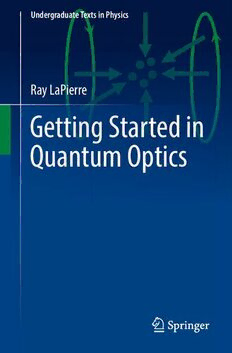Table Of ContentUndergraduate Texts in Physics
Ray LaPierre
Getting Started in
Quantum Optics
Undergraduate Texts in Physics
SeriesEditors
KurtH.Becker,NYUPolytechnicSchoolofEngineering,Brooklyn,NY,USA
Jean-MarcDiMeglio,MatièreetSystèmesComplexes,UniversitéParisDiderot,
BâtimentCondorcet,Paris,France
SadriD.Hassani,UniversityofIllinoisatUrbana-Champaign,Urbana,IL,USA
MortenHjorth-Jensen,UniversityofOslo,Oslo,Norway
MichaelInglis,Patchogue,NY,USA
BillMunro,NTTBasicResearchLaboratories,OpticalScienceLaboratories,
Atsugi,Kanagawa,Japan
SusanScott,AustralianNationalUniversity,Acton,ACT,Australia
MartinStutzmann,WalterSchottkyInstitute,TechnicalUniversityofMunich,
Garching,Bayern,Germany
UndergraduateTextsinPhysics(UTP)publishesauthoritativetextscoveringtopics
encounteredinaphysicsundergraduatesyllabus.Eachtitleintheseriesissuitableas
an adopted text for undergraduate courses, typically containing practice problems,
worked examples, chapter summaries, and suggestions for further reading. UTP
titles should provide an exceptionally clear and concise treatment of a subject at
undergraduatelevel,usuallybasedonasuccessfullecturecourse.Coreandelective
subjectsareconsideredforinclusioninUTP.
UTPbookswillbeidealcandidatesforcourseadoption,providinglecturerswith
a firm basis for development of lecture series, and students with an essential
referencefortheirstudiesandbeyond.
Ray LaPierre
Getting Started in Quantum
Optics
RayLaPierre
Hamilton,ON,Canada
ISSN2510-411X ISSN2510-4128 (electronic)
UndergraduateTextsinPhysics
ISBN978-3-031-12434-1 ISBN978-3-031-12432-7 (eBook)
https://doi.org/10.1007/978-3-031-12432-7
©TheEditor(s)(ifapplicable)andTheAuthor(s),underexclusivelicensetoSpringerNatureSwitzerland
AG2022
Thisworkissubjecttocopyright.AllrightsaresolelyandexclusivelylicensedbythePublisher,whether
thewholeorpartofthematerialisconcerned,specificallytherightsoftranslation,reprinting,reuseof
illustrations, recitation, broadcasting, reproduction on microfilms or in any other physical way, and
transmission or information storage and retrieval, electronic adaptation, computer software, or by
similarordissimilarmethodologynowknownorhereafterdeveloped.
Theuseofgeneraldescriptivenames,registerednames,trademarks,servicemarks,etc.inthispublication
doesnotimply,evenintheabsenceofaspecificstatement,thatsuchnamesareexemptfromtherelevant
protectivelawsandregulationsandthereforefreeforgeneraluse.
The publisher, the authors, and the editorsare safeto assume that the adviceand informationin this
bookarebelievedtobetrueandaccurateatthedateofpublication.Neitherthepublishernortheauthorsor
theeditorsgiveawarranty,expressedorimplied,withrespecttothematerialcontainedhereinorforany
errorsoromissionsthatmayhavebeenmade.Thepublisherremainsneutralwithregardtojurisdictional
claimsinpublishedmapsandinstitutionalaffiliations.
ThisSpringerimprintispublishedbytheregisteredcompanySpringerNatureSwitzerlandAG
Theregisteredcompanyaddressis:Gewerbestrasse11,6330Cham,Switzerland
Preface
Getting Started in Quantum Optics was born from lecture notes developed for an
introductory course in quantum optics offered to undergraduate students in the
Department of Engineering Physics at McMaster University (Hamilton, Ontario,
Canada). The book was written for students who have completed an introductory
course on quantum mechanics and electromagnetism, but otherwise have no back-
groundinquantumoptics.GettingStartedinQuantumOpticsismostlyintendedasa
self-contained introduction to the theory of quantum optics with the beginner
inmind.
This book covers canonical quantization, the quantumharmonic oscillator, vac-
uumfluctuations,Fockstates,thesinglephotonstate,thequantumopticstreatment
ofthebeamsplitterandtheinterferometer,multimodequantizedlight,andcoherent
andincoherentstates.Thebookprovidesatreatmentofsqueezedlightanditsusein
the Laser Interferometer Gravitational-Wave Observatory (LIGO). The Heisenberg
limitisdescribed,alongwithNOONstatesandtheirapplicationinsuper-sensitivity,
super-resolution,andquantumlithography.Applicationsofentanglementandcoin-
cidence measurements are described including ghost imaging, quantum illumina-
tion, absolute photodetector calibration, and interaction-free measurement. Light-
matter interaction,atomicclocks,andatomcoolingandtrappingareincluded.The
bookdoesnotcoverquantumcomputing,whichisatopictreatedbyanotherbookby
theauthor[1].Togetherwithquantumcomputing,thetopicsofthisbookattemptto
form an almost complete introductory description of the “second quantum
revolution”.
Sincethebookisintended fortheundergraduate beginner,Itrynottosay“itis
easytoshow”toooften.Rigorousderivationsaregiven,althoughsomecalculations
are completed as exercises in the book and heuristic arguments are occasionally
employedtoavoidgettingboggeddowntoomuchincalculations.Theemphasisis
onphysicalunderstanding.Thus,insomeinstances,asimplificationofthetopicsis
presentedforpedagogicalreasons.Forexample,thecanonicalquantizationoflight
v
vi Preface
is presented using entirely electric and magnetic fields, rather than the usual
approach of using the vector potential. I do not use density matrices anywhere in
this book. Students are expected to be familiar with the Dirac bra-ket notation and
tensorproductofstates.
Reference
1. RayLaPierre,IntroductiontoQuantumComputing(Springer,2021).https://doi.
org/10.1007/978-3-030-69318-3
Acknowledgments
Iam grateful toMcMaster University, theDepartment of EngineeringPhysics,my
many colleagues, my students, and my family for inspiring me to write this book.
Anyerrorsinthebookareentirelymyown.
vii
How to Use This Book
Thisbookisintendedforasinglesemester(~12week)electivecourseonquantum
optics,comprisedofapproximately361-hourlectures(3hoursperweek).Chapters
are intended to be covered consecutively. Instructors may wish to begin with an
overviewofthebra-ketnotation,innerproduct,expectationvalues,tensorproduct,
andrelatedtopics.Asuggestedlecturescheduleis:
Lecture1:Chap.1–CanonicalQuantization
Lecture2–3:Chap.2–QuantumHarmonicOscillator
Lecture4–5:Chap.3–CanonicalQuantizationofLight
Lecture6:Chap.4–FockStatesandtheVacuum
Lecture7:Chap.5–SinglePhotonState
Lecture8–9:Chap.6–SinglePhotononaBeamSplitter
Lecture10–11:Chap.7–SinglePhotoninanInterferometer
Lecture12:Chap.8:Entanglement
Lecture13–14:Chap.9–MultimodeQuantizedRadiation
Lecture15–16:Chap.10–CoherentState
Lecture17:Chap.11–CoherentStateonaBeamSplitter
Lecture18–19:Chap.12–IncoherentState
Lecture20–21:Chap.13–HomodyneandHeterodyneDetection
Lecture22–23:Chap.14–CoherentStateinanInterferometer
Lecture24–25:Chap.15–SqueezedLight
Lecture26–27:Chap.16–SqueezedLightinanInterferometer
Lecture28–29:Chap.17–HeisenbergLimit
Lecture30–31:Chap.18–QuantumImaging
Lecture32–33:Chap.19–Light–MatterInteraction
Lecture34:Chap.20–AtomicClock
Lecture35–36:Chap.21–AtomCoolingandTrapping
The book assumes that students have successfully completed an introductory
course in quantum mechanics, which is typically in the second year of a 4-year
undergraduateprograminphysicsorrelateddisciplines.Thus,thisbookisintended
ix
x HowtoUseThisBook
asacourseforthethirdorfourthyearofanundergraduateprogram,ortheentrylevel
ofagraduateprogram.
Each chapter includes exercises which can be completed by the student as
homework assignments or used for tutorial instruction. A solutions manual is
available from the publisher for qualified instructors. Each chapter also includes
references for more advanced study, and further reading is listed at the end of
thebook.

